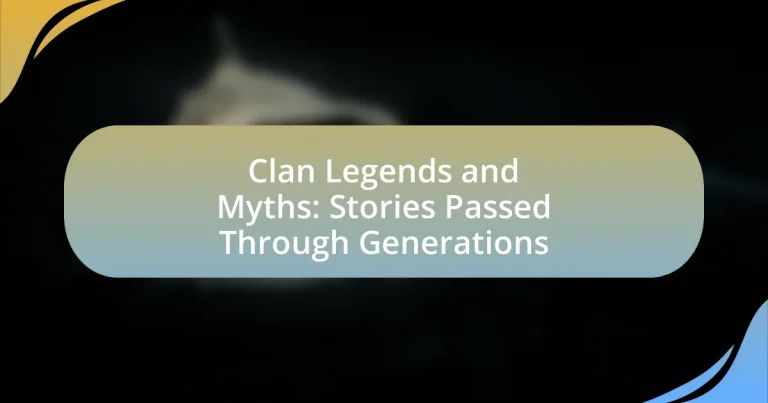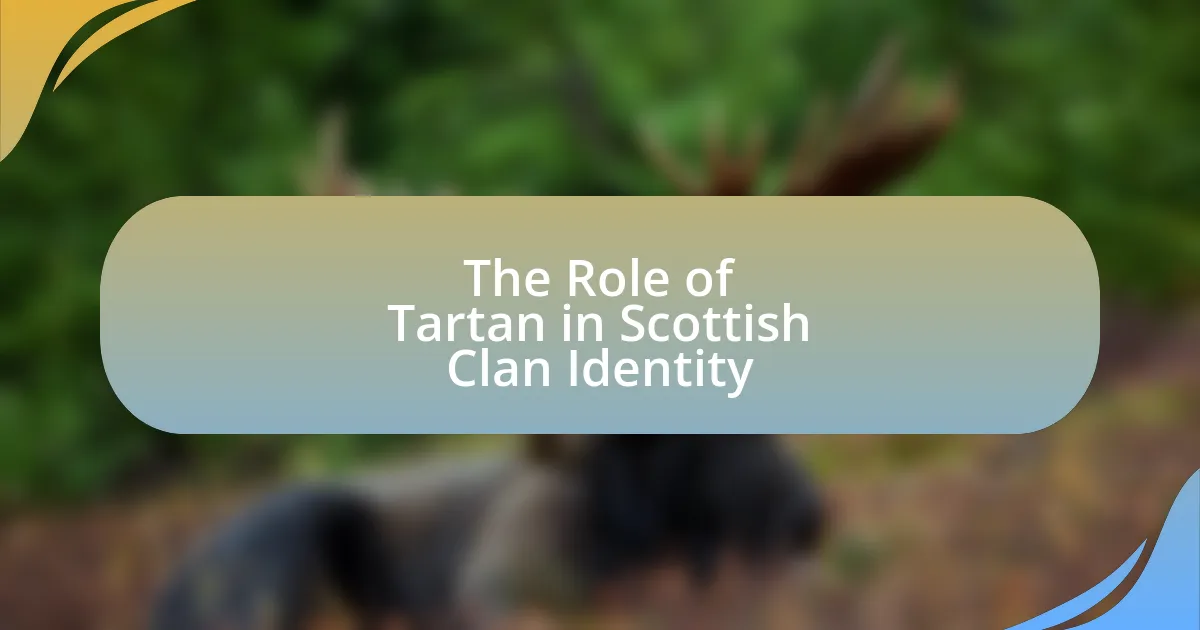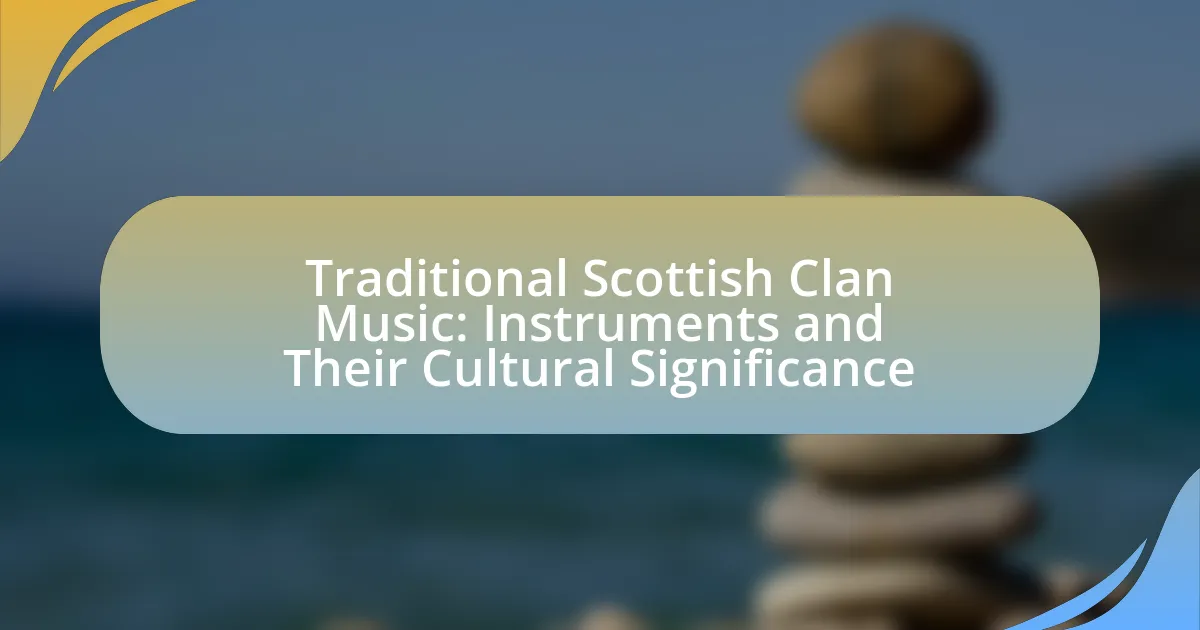Clan legends and myths are traditional narratives that encapsulate the history, values, and beliefs of specific clans or communities, often featuring heroic figures and moral lessons. These stories originate from collective experiences and significant historical events, serving to reinforce cultural identity and social cohesion. The article explores the origins of these legends, the cultural factors influencing their creation, and their importance in fostering community bonds and preserving cultural heritage. Additionally, it examines the roles of heroes and villains within these narratives, the impact of modern adaptations, and the insights they provide into human behavior and resilience.
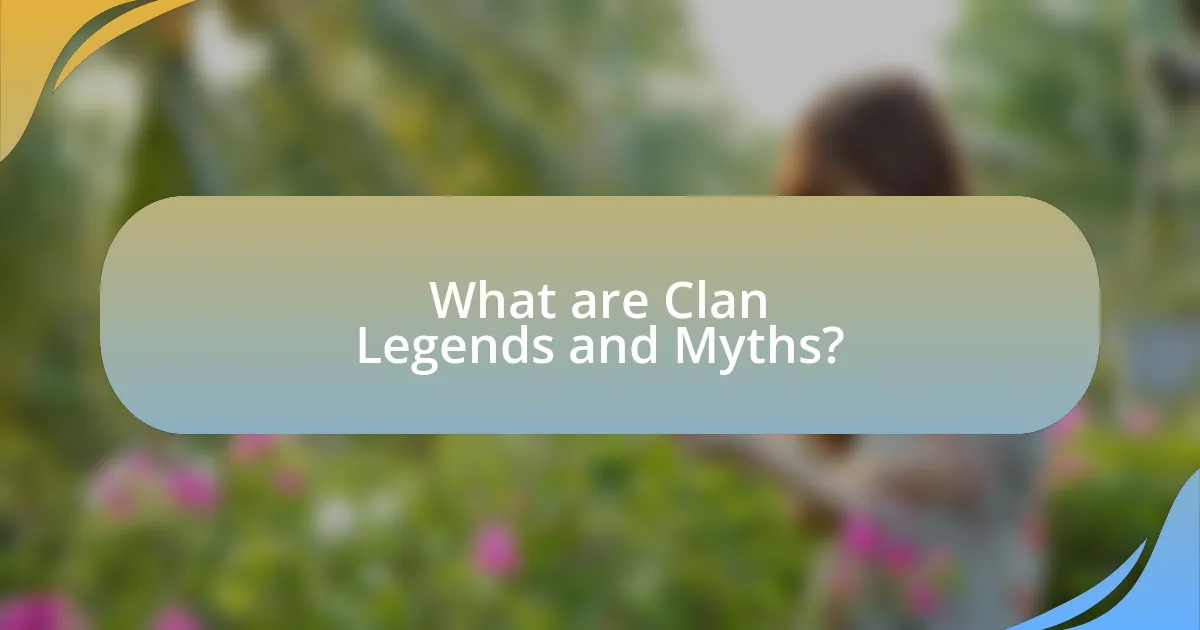
What are Clan Legends and Myths?
Clan legends and myths are traditional narratives that convey the history, values, and beliefs of a specific clan or community. These stories often feature heroic figures, supernatural events, and moral lessons, serving to strengthen group identity and cultural heritage. For example, many Indigenous tribes in North America have legends that explain their origins and the natural world, which are passed down orally through generations, reinforcing social cohesion and cultural continuity.
How do Clan Legends and Myths originate?
Clan legends and myths originate from the collective experiences, beliefs, and values of a community, often passed down orally through generations. These narratives typically arise from historical events, cultural practices, and significant figures within the clan, serving to reinforce identity and social cohesion. For example, many indigenous cultures have creation myths that explain their origins and relationship with the land, reflecting their worldview and moral lessons. The process of storytelling, combined with the embellishment and reinterpretation over time, contributes to the evolution of these legends, ensuring they remain relevant to contemporary audiences while preserving the clan’s heritage.
What cultural factors influence the creation of these stories?
Cultural factors that influence the creation of clan legends and myths include shared beliefs, historical events, social structures, and environmental contexts. These elements shape the narratives by reflecting the values, morals, and experiences of the community. For instance, oral traditions often incorporate local geography and historical events, which serve to reinforce group identity and continuity. Additionally, the roles of elders and storytellers in preserving and transmitting these stories highlight the importance of authority and respect within the culture. Such factors ensure that the legends remain relevant and resonate with the community’s collective memory and identity.
How do historical events shape Clan Legends and Myths?
Historical events shape Clan Legends and Myths by providing the foundational narratives that clans use to explain their origins, values, and identity. For instance, significant battles, migrations, or alliances often become central themes in clan stories, illustrating bravery, loyalty, or resilience. The Battle of Culloden in 1746, for example, is a pivotal event in Scottish history that has influenced numerous clan legends, embedding themes of loss and resistance into their cultural narratives. These legends serve not only to preserve history but also to instill a sense of belonging and continuity among clan members, reinforcing their collective identity through shared experiences and values derived from actual historical occurrences.
Why are Clan Legends and Myths important to communities?
Clan legends and myths are important to communities because they serve as a means of cultural identity and cohesion. These narratives encapsulate shared values, beliefs, and historical experiences, fostering a sense of belonging among members. For instance, many indigenous cultures utilize legends to transmit moral lessons and communal history, reinforcing social norms and collective memory. Research indicates that storytelling, including myths, enhances community bonds and provides a framework for understanding the world, as seen in studies by anthropologists like Claude Lévi-Strauss, who emphasized the role of myths in social structure. Thus, clan legends and myths are vital for maintaining cultural continuity and unity within communities.
What role do these stories play in cultural identity?
Clan legends and myths play a crucial role in shaping cultural identity by preserving shared values, beliefs, and historical narratives within a community. These stories serve as a means of transmitting cultural heritage across generations, reinforcing a sense of belonging and continuity among members of the clan. For instance, many indigenous cultures utilize oral traditions to convey moral lessons and historical events, which not only educate younger generations but also strengthen communal ties. Research indicates that storytelling fosters social cohesion and identity formation, as seen in studies highlighting the importance of narrative in maintaining cultural practices and collective memory.
How do Clan Legends and Myths foster community bonds?
Clan legends and myths foster community bonds by providing shared narratives that reinforce group identity and values. These stories often encapsulate the history, struggles, and triumphs of the clan, creating a sense of belonging among members. For example, in many cultures, legends serve as moral lessons that guide behavior and strengthen social cohesion. Research indicates that storytelling within communities enhances interpersonal connections and promotes collective memory, which is essential for maintaining cultural heritage. By participating in the retelling of these myths, individuals feel a deeper connection to their clan, thereby solidifying communal ties.
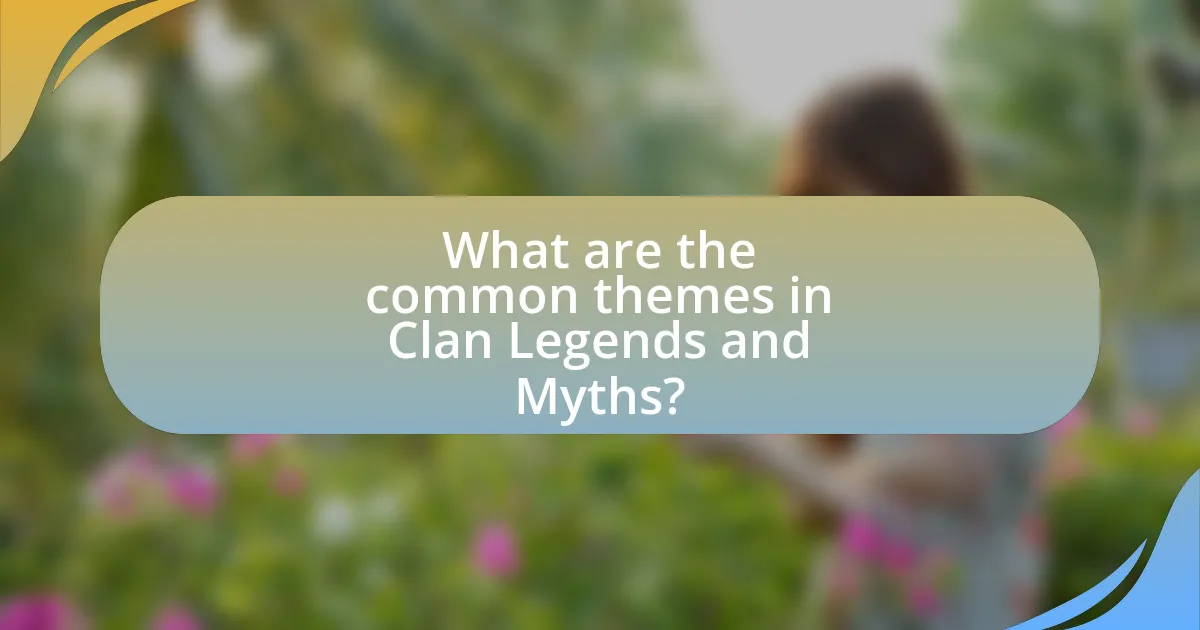
What are the common themes in Clan Legends and Myths?
Common themes in Clan Legends and Myths include the importance of ancestry, the valorization of heroic deeds, and the moral lessons conveyed through storytelling. Ancestry is often emphasized as clans recount their origins and lineage, reinforcing identity and belonging. Heroic deeds are celebrated, showcasing bravery and sacrifice, which serve as ideals for clan members to aspire to. Additionally, moral lessons are embedded within these narratives, teaching values such as loyalty, justice, and respect for nature, which are crucial for maintaining social cohesion within the clan. These themes are consistently observed across various cultures, highlighting their universal significance in preserving clan identity and values through generations.
How do heroes and villains appear in these stories?
Heroes in clan legends and myths typically embody qualities such as bravery, honor, and selflessness, often undertaking quests or battles to protect their community. These characters are frequently depicted as larger-than-life figures who possess extraordinary abilities or wisdom, serving as role models for the values upheld by the clan. Villains, in contrast, are portrayed as embodiments of chaos, greed, or betrayal, often challenging the heroes and threatening the stability of the community. Their actions usually serve as a catalyst for the hero’s journey, highlighting the moral lessons inherent in the stories. For example, in many cultures, the hero’s triumph over the villain reinforces the importance of virtue and the consequences of vice, illustrating the duality of good and evil within the narrative framework.
What characteristics define the heroes in Clan Legends?
The heroes in Clan Legends are defined by their bravery, loyalty, and exceptional skills. These characteristics are often highlighted through their courageous acts in battle, unwavering commitment to their clan, and mastery of unique abilities or weapons. For instance, many heroes are depicted as fearless warriors who protect their people against formidable foes, showcasing their bravery. Their loyalty is evident in their willingness to sacrifice personal safety for the greater good of their clan, reinforcing the importance of community and kinship in these legends. Additionally, their exceptional skills, whether in combat or strategy, set them apart as leaders and protectors, making them central figures in the narratives that have been passed down through generations.
How are villains portrayed in these myths?
Villains in clan legends and myths are often portrayed as embodiments of chaos and moral corruption, serving as antagonists to the heroes. These characters typically possess traits such as greed, jealousy, or a thirst for power, which drive them to commit acts that threaten the community or the hero’s journey. For example, in many myths, villains may engage in treachery or deceit, reflecting societal fears and moral lessons about the consequences of such behaviors. This portrayal serves to reinforce the values of the community, illustrating the importance of virtue and the dangers of straying from moral paths.
What supernatural elements are often included?
Supernatural elements often included in clan legends and myths are spirits, deities, magical creatures, and supernatural events. These elements serve to explain natural phenomena, convey moral lessons, and connect the clan’s identity to a larger cosmological framework. For instance, many cultures feature ancestral spirits that guide or protect their descendants, while mythical creatures like dragons or fairies symbolize power or wisdom. Additionally, supernatural events such as prophecies or miraculous occurrences reinforce the significance of the legends within the clan’s history and cultural narrative.
How do these elements enhance the storytelling?
Clan legends and myths enhance storytelling by providing cultural context and emotional resonance. These elements create a shared identity among members of a clan, fostering a sense of belonging and continuity. For instance, the use of specific symbols and motifs within these stories often reflects the values and beliefs of the community, making the narratives more relatable and impactful. Research indicates that oral traditions, such as clan legends, serve as a means of preserving history and imparting moral lessons, which reinforces community bonds and collective memory.
What significance do mythical creatures hold in Clan Legends?
Mythical creatures in Clan Legends serve as symbols of cultural identity and moral lessons. These creatures often embody the values, fears, and aspirations of the clan, acting as guardians or guides in their narratives. For instance, dragons may represent strength and wisdom, while fairies could symbolize mischief and the unpredictability of nature. The presence of these beings in stories reinforces communal bonds and transmits important cultural teachings across generations, ensuring that the clan’s heritage and beliefs are preserved.
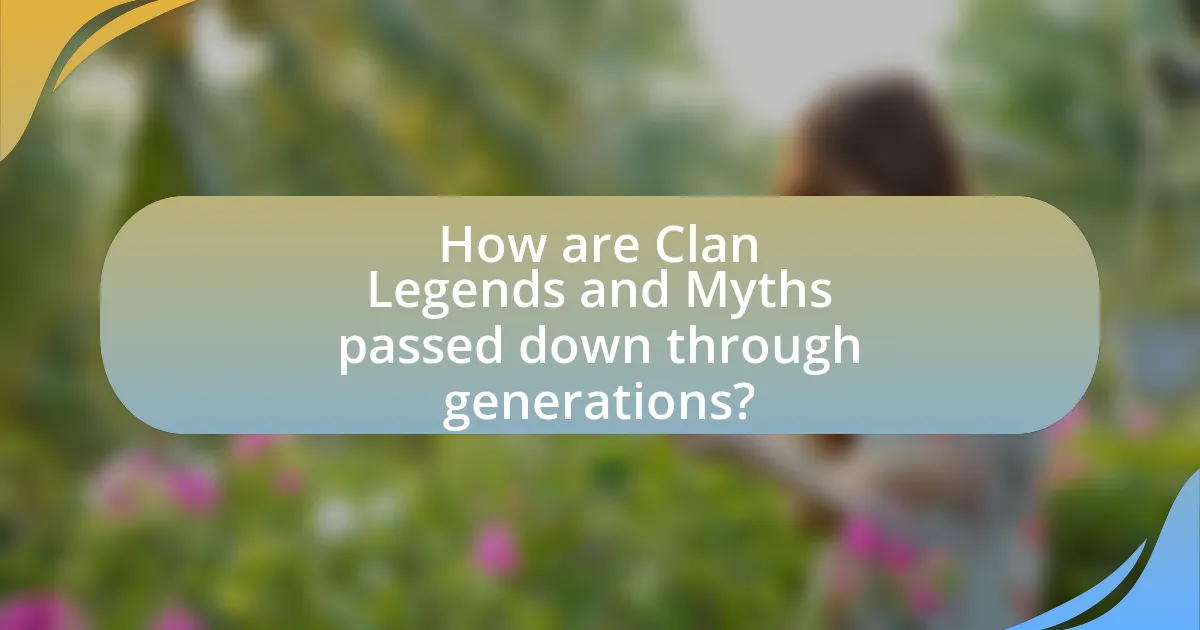
How are Clan Legends and Myths passed down through generations?
Clan legends and myths are passed down through generations primarily through oral tradition, storytelling, and cultural rituals. Oral tradition involves the sharing of stories by word of mouth, often during gatherings or ceremonies, which allows for the preservation of narratives that reflect the clan’s identity and values. Storytelling serves as a means to engage younger members, ensuring they learn about their heritage and the lessons embedded in these tales. Cultural rituals, such as festivals or rites of passage, often incorporate these legends, reinforcing their significance and ensuring they remain a vital part of the clan’s collective memory. This method of transmission has been documented in various anthropological studies, highlighting its effectiveness in maintaining cultural continuity across generations.
What methods are used to share these stories?
Clan legends and myths are shared through oral traditions, written texts, and digital media. Oral storytelling is the most traditional method, where elders narrate stories to younger generations during gatherings, ensuring cultural continuity. Written texts, such as books and articles, document these stories for broader audiences, preserving them for future reference. Digital media, including podcasts and social media platforms, allows for wider dissemination and engagement with these narratives, reaching diverse audiences globally. These methods collectively ensure that clan legends and myths are passed down effectively through generations.
How does oral tradition play a role in preserving Clan Legends?
Oral tradition is crucial in preserving Clan Legends as it facilitates the transmission of stories, values, and cultural identity across generations. This method of storytelling allows clans to maintain a collective memory, ensuring that legends are not lost over time. For instance, many Indigenous cultures rely on oral narratives to pass down historical events, moral lessons, and clan ancestry, which are often recounted during communal gatherings or rituals. Research indicates that oral traditions can enhance community cohesion and identity, as seen in studies of various tribal societies where storytelling serves as a means of reinforcing social bonds and cultural heritage.
What impact do written records have on these stories?
Written records significantly enhance the preservation and transmission of clan legends and myths. By documenting these stories, written records provide a reliable means to maintain the accuracy and consistency of narratives across generations, reducing the risk of distortion that can occur through oral retelling. Historical examples, such as the recording of Native American myths in the 19th century, illustrate how written documentation has allowed for the survival of cultural heritage that might otherwise have been lost. Furthermore, written records enable broader accessibility, allowing individuals outside the original cultural context to engage with and understand these stories, thereby fostering cross-cultural appreciation and scholarship.
How do modern adaptations affect Clan Legends and Myths?
Modern adaptations significantly alter Clan Legends and Myths by reinterpreting traditional narratives to resonate with contemporary audiences. These adaptations often introduce new themes, characters, and settings that reflect current societal values and issues, thereby transforming the original stories. For instance, adaptations in film and literature frequently emphasize themes of diversity and inclusion, which may not have been present in the original legends. This shift can lead to a broader understanding and appreciation of the myths, as they become more relatable to modern viewers. Additionally, the use of technology in storytelling, such as animation and interactive media, allows for a more immersive experience, further engaging audiences and ensuring the legends remain relevant.
What are the implications of retelling these stories in contemporary media?
Retelling clan legends and myths in contemporary media can significantly influence cultural identity and societal values. By adapting these stories, media can reinforce traditional beliefs and practices, fostering a sense of belonging among community members. For instance, the resurgence of indigenous narratives in films and television has been shown to enhance cultural pride and awareness, as evidenced by the success of productions like “Rumble: The Indians Who Rocked the World,” which highlights the contributions of Native American musicians. Furthermore, contemporary retellings can challenge stereotypes and promote understanding by presenting diverse perspectives, as seen in the adaptation of folklore in modern storytelling formats. This dual role of preserving heritage while encouraging dialogue underscores the importance of these narratives in shaping contemporary cultural landscapes.
How do adaptations influence the perception of Clan Legends?
Adaptations significantly influence the perception of Clan Legends by altering their narratives and cultural significance. When stories are adapted into different mediums, such as literature, film, or oral retellings, they often reflect contemporary values and societal norms, which can reshape the original meanings. For instance, adaptations may emphasize certain heroic traits or moral lessons that resonate with modern audiences, thereby changing how these legends are understood and appreciated. This phenomenon is evident in adaptations of traditional myths, where the portrayal of characters and events can shift dramatically, leading to a re-evaluation of the clan’s identity and heritage. Such reinterpretations can either reinforce or challenge existing beliefs about the clan, demonstrating the dynamic nature of cultural storytelling.
What can we learn from Clan Legends and Myths today?
Clan legends and myths today teach us about cultural identity and shared values. These narratives often encapsulate the history, morals, and traditions of a community, providing insight into their collective experiences and beliefs. For instance, many clan myths serve as cautionary tales that emphasize virtues such as bravery, loyalty, and respect for nature, which are essential for social cohesion. Additionally, studies have shown that storytelling fosters a sense of belonging and continuity within communities, reinforcing social bonds across generations. This demonstrates the enduring relevance of clan legends and myths in shaping contemporary cultural landscapes.
How can these stories provide insights into human behavior?
Clan legends and myths provide insights into human behavior by reflecting the values, beliefs, and social norms of the cultures that create them. These narratives often illustrate moral lessons, social hierarchies, and communal identities, which shape individual and collective behavior. For example, stories that emphasize bravery or loyalty can reinforce these traits within a community, guiding members on how to act in various situations. Research indicates that storytelling is a fundamental way humans communicate complex ideas and emotions, as seen in studies by psychologists like Jerome Bruner, who argue that narratives help individuals make sense of their experiences and the world around them. Thus, clan legends and myths serve as a mirror to human behavior, revealing underlying motivations and societal expectations.
What lessons do Clan Legends and Myths teach about resilience and community?
Clan legends and myths teach that resilience and community are essential for overcoming adversity. These narratives often depict characters who face significant challenges but ultimately prevail through collective effort and support from their community. For instance, many myths illustrate how clans unite in times of crisis, showcasing the importance of solidarity and shared strength. Historical examples, such as the tales of the Iroquois Confederacy, highlight how cooperation among tribes led to survival and prosperity, reinforcing the idea that resilience is often a communal endeavor. Such stories emphasize that enduring hardships together fosters a stronger, more cohesive community, illustrating the vital role of collaboration in achieving resilience.
How can one effectively engage with Clan Legends and Myths?
To effectively engage with Clan Legends and Myths, one should actively participate in storytelling sessions and community gatherings where these narratives are shared. Engaging in these cultural practices allows individuals to connect with their heritage and understand the significance of the legends within their clan. Research indicates that oral traditions, such as storytelling, are crucial for preserving cultural identity and fostering community bonds, as highlighted in the work of anthropologist Barbara B. Smith in “Oral Traditions and Cultural Identity.” By listening to and sharing these stories, individuals not only honor their ancestors but also contribute to the ongoing legacy of their clan’s history.
